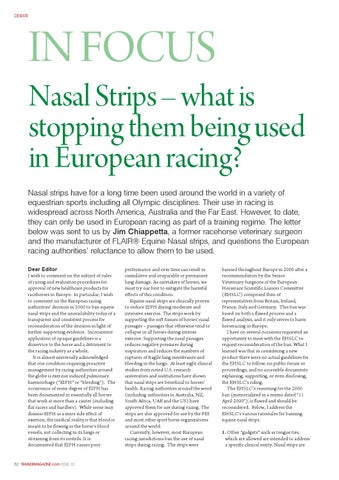letter issue 32.qxd:Jerkins feature.qxd
26/11/10
17:20
Page 1
DEBATE
IN FOCUS
Nasal Strips – what is stopping them being used in European racing?
Nasal strips have for a long time been used around the world in a variety of equestrian sports including all Olympic disciplines. Their use in racing is widespread across North America, Australia and the Far East. However, to date, they can only be used in European racing as part of a training regime. The letter below was sent to us by Jim Chiappetta, a former racehorse veterinary surgeon and the manufacturer of FLAIR® Equine Nasal strips, and questions the European racing authorities’ reluctance to allow them to be used. Dear Editor I wish to comment on the subject of rules of racing and evaluation procedures for approval of new healthcare products for racehorses in Europe. In particular, I wish to comment on the European racing authorities’ decision in 2000 to ban equine nasal strips and the unavailability today of a transparent and consistent process for reconsideration of the decision in light of further supporting evidence. Inconsistent application of opaque guidelines is a disservice to the horse and a detriment to the racing industry as a whole. It is almost universally acknowledged that one condition requiring proactive management by racing authorities around the globe is exercise induced pulmonary haemorrhage (“EIPH” or “bleeding”). The occurrence of some degree of EIPH has been documented in essentially all horses that work at more than a canter (including flat racers and hurdlers). While some may dismiss EIPH as a mere side effect of exertion, the medical reality is that blood is meant to be flowing in the horse’s blood vessels, not collecting in its lungs or streaming from its nostrils. It is documented that EIPH causes poor
52 TRAINERMAGAZINE.com ISSUE 32
performance and over time can result in cumulative and irreparable or permanent lung damage. As caretakers of horses, we must try our best to mitigate the harmful effects of this condition. Equine nasal strips are clinically proven to reduce EIPH during moderate and intensive exercise. The strips work by supporting the soft tissues of horses’ nasal passages – passages that otherwise tend to collapse in all horses during intense exercise. Supporting the nasal passages reduces negative pressures during inspiration and reduces the numbers of ruptures of fragile lung membranes and bleeding in the lungs. At least eight clinical studies from noted U.S. research universities and institutions have shown that nasal strips are beneficial to horses’ health. Racing authorities around the word (including authorities in Australia, NZ, South Africa, UAE and the US) have approved them for use during racing. The strips are also approved for use by the FEI and most other sport horse organizations around the world. Currently, however, most European racing jurisdictions ban the use of nasal strips during racing. The strips were
banned throughout Europe in 2000 after a recommendation by the Senior Veterinary Surgeons of the European Horserace Scientific Liaison Committee (EHSLC) comprised then of representatives from Britain, Ireland, France, Italy and Germany. This ban was based on both a flawed process and a flawed analysis, and it only serves to harm horseracing in Europe. I have on several occasions requested an opportunity to meet with the EHSLC to request reconsideration of the ban. What I learned was that in considering a new product there were no actual guidelines for the EHSLC to follow, no public forum or proceedings, and no accessible documents explaining, supporting, or even disclosing, the EHSLC’s ruling. The EHSLC’s reasoning for the 2000 ban (memorialized in a memo dated “11 April 2000”), is flawed and should be reconsidered. Below, I address the EHSLC’s various rationales for banning equine nasal strips. 1. Other “gadgets” such as tongue ties, which are allowed are intended to address a specific clinical entity. Nasal strips are
